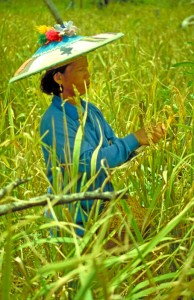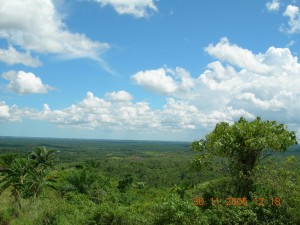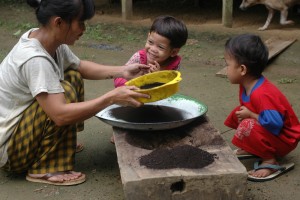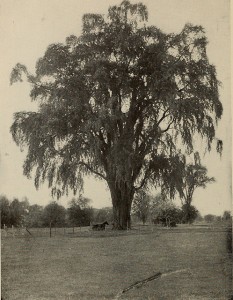Rebecca Elmhirst is researching how oil palm production affects men and women in local communities in East Kalimantan, Indonesia. Here she speaks about the difficulties in interpreting gender roles in different contexts and her fascination with gender research.
Could you describe what this project is about?
Our intention is to look at the gender dimensions of oil palm investments in East Kalimantan, Indonesia. What we really want to do is to move away from a simplistic view that sees oil palm only as something bad, and instead look at all of the different contexts in which oil palm becomes a factor in peoples lives. So we chose five different communities that represent rather different engagements with oil palm.

Three of our sites were Dayak communities, where ancestral lands were taken over by oil palm companies. These people were being displaced and many women became wage laborers on the oil palm plantations. Men continued with their swiddens and orchards as far as was possible. Most were finding it difficult to maintain their traditional livelihoods because they had lost access to nearby fields and forest resources and had to travel much further to their fields.
A key gender issue was how women had to juggle oil palm wage work, getting to now-distant rice fields and domestic tasks. By contrast, our fourth site example was a former transmigration settlement made up of mostly Javanese migrants with formal land certificates. This meant that their land was not incorporated into oil palm concessions.
Instead they benefited – to some extent – from the additional opportunities oil palm investments can bring, as workers brought in by the companies provided a market for small businesses, many of which were run by women, for example, small kiosks or street food – very much the traditional domain of Javanese women.
The fifth site we investigated was a community dominated by smallholder independent investment in oil palm. This community was made up of people who originally came from other parts of Indonesia, and had been working in oil palm plantations in Malaysia.
They came to this area to start to plant oil palm as small holders. Interestingly, they were using remittances from their work in Malaysia and benefited from the knowledge they had acquired working for oil palm companies over there.
This made for a very different sort of dynamic. These were not Dayak communities, but migrants largely from Sulawesi, Lombok and other islands. So the gender dynamic was very different from the other communities.
What we wanted to do was to make a comparison between the effects of oil palm on gender relations in those different scenarios, which represented different kinds of incorporation of communities into oil palm systems. We also looked at different gender norms associated with particular ethnic groups, and different income groups.
The Indonesia case study is part of the CGIAR global study on gender norms. In your study, how are you approaching gender norms conceptually and methodologically?

Our interest in gender norms comes from the assumption that norms can change, that gender is not necessarily clearly fixed as an organizing principle. There are ways in which divisions of labor by gender, for instance, can alter, depending on the circumstances.
We are also interested in looking also at how gender norms intersect with norms associated with ethnicity, for example, which is very important in the Indonesian context.
Additionally we focused on the inter-generational dynamics, the differences in gender norms between young people and older people. That was another way in which we conceptually tried to capture this idea of changing norms.
That was our starting point. We worked very closely within the GENNOVATE framework, but we adjusted it slightly to look at agricultural innovations from a particular angle. We look at how oil palm can either be an innovation itself or prompt the development of other innovations as people deal with the livelihood stresses it can bring.
Apart from that, we also look at how certain kinds of gender norms facilitate particular kinds of investment, what is most readily accepted in a particular community.
Some quite interesting findings came out in relation to that, for example, in terms of some migrant women from particular ethnic groups taking on roles as land brokers in the smallholder oil palm investment in one of the cases, replicating a networking role they often play other social domains. We also emphasize broader structural issues that have a bearing on resource access by men and women, for example, competing claims over resource access and entitlement between state and customary institutions.
What do you think this project can achieve?
I think it can really make it clearer how gender is a critical factor in understanding change in society and what’s happening in natural resource management. If you don’t look at gender then you’re going to be missing some crucial issues around issues like food security. It’s important not only to recognize gender as a critical variable, but also to do away with some of the assumptions that we’ve made about gender – about seeing women always as victims, about seeing women as somehow being less active.
What I like about the way in which we’re undertaking this study is that we’re not considering gender as something that’s only about women, but also about male points of view and changing norms of masculinity.

The kinds of changes we’re seeing in meanings of masculinity, and how people relate to it can also be profoundly unsettling, with social effects that perhaps aren’t normally within the domain of natural resource management analysis. This includes, for example, social conflict within households, violence against women or domestic violence more generally. These and other forms of social dislocation can sometimes accompany the big-scale changes that oil palm can bring about.
You’ve done a lot of work in Southeast Asia. I wanted to ask you about the complexities and difficulties associated with conducting cross-cultural research, especially when studying complex and often context-specific gender norms. Have any such challenges emerged during this project, and how have you dealt with them?
I think Southeast Asia is a very interesting place to investigate gender, because it’s a region that’s generally considered relatively non-hierarchical in relation to gender. A lot of the anthropological literature has pointed to Southeast Asia as being very gender-egalitarian, which means that gender can be missed as researchers focus instead on more immediately obvious distinctions such as class or ethnic difference.
But if you start digging a little deeper, you can see other ways in which gender matters, and how sometimes things we read as signs of women’s empowerment might be – within the local context – signs of women actually not being particularly powerful.
The example often given is women being responsible for handling money and household finances. But in Southeast Asia, handling money in that way may be seen as dirty or unclean, the kind of thing people with status wouldn’t openly involve themselves in. So our readings of the status of the genders need to be a little more nuanced.
This poses big challenges in a cross-cultural study, where your local knowledge of the context would lead you to interpret a quote from a Dayak woman in a particular way, but where the same words uttered by a woman in a Latin American context might carry a rather different meaning. Making these subtle ethnographic interpretations across such a large number of cases from very different cultural contexts is a real challenge.
The way in which we’ve tried to address this issue in our East Kalimantan study is by constantly being self-critical and thinking carefully about how this compares with other places in Indonesia in which the members of the team have worked.
But also we have sought to work very closely with the team tasked with devising the coding for the qualitative data analysis in the global study, to possibly flag the differences of interpretations.
There are no simple answers, no straightforward ways of getting around this, but I think we need to maintain a sense of that complexity and differences across different cultures with different gender norms, but without losing sight of the overall message of the global study and the wider comparative findings.
And this is where our Southeast Asian case study could play an important role. This is something that people working with gender and natural resource management and agriculture have been grappling with for years.
You are a principal lecturer in human geography at the University of Brighton, with a specific focus on environment, gender, development and Indonesia. Could you briefly describe how you got to be where you are today, and how you came to focus on gender and Indonesia?
I started my academic career at Newcastle University as an undergraduate working with Janet Momsen. She was starting to work on what at that time was known as Women in Development. I was really taken by that, and after graduating, I spent some time in Southeast Asia travelling.
I became very fascinated by the apparent disconnect between what I saw and what was being described in the women in development literature from other parts of the world. This literature at that time didn’t seem to quite ‘work’ in a Southeast Asian context – so I wanted to know more.
I then did a Master’s degree at the University of British Colombia, also in geography, working with Terry McGee. For my thesis I was looking at gender in Indonesia at a macro level. And after a spell outside academia I returned to Indonesia to do field work for my PhD, based at Wye College, University of London, working on the local transmigration resettlement program in Lampung, Indonesia.
And initially my intention wasn’t to look at gender in particular, I was interested in resettlement, agro-ecological adaptation and inter-ethnic relations between Javanese transmigrants and local people.
But I couldn’t escape gender. It was really interesting to see how gender became important and how local people were talking about themselves in relation to these newcomers who’d arrived with the trans-migration program.
Gender had a real significance in terms of how different ethnicities were comparing themselves with other ethnic groups. I was interested in looking at that dynamic, and also the ways in which division of labor between women and menwas shifting as the agrarian context changed.
When I did my PhD in Indonesia, I was one of the first PhD students that ICRAF in Bogor sponsored. I worked very closely with Meine van Noordvijk and Thomas Tomich, and was lucky enough to be able to stay at the ‘base camp’ belonging to Brawijaya University in North Lampung (now part of Way Kanan district) for some of the fieldwork.
From then on I’ve continued doing different kinds of projects mostly in Indonesia and mostly trying to think more carefully about gender in contexts where migration is important. That’s one strand of my work that I’ve been able to integrate into the GENNOVATE study, even though migration was not part of the remit for the methodology.
It’s very difficult to sidestep migration; it’s important in all parts of the world and something that those working in natural resource management constantly come up against.

Given that this is the newsletter for the CGIAR Research Program on Forests, Trees and Agroforestry, it is important to our readers to know: if you were a tree, which tree would you be, and why?
Well, I’ve got to say: an elm tree, because of my name – Elmhirst means basically a small clump of elm trees. I’ve just been so saddened by what’s happened to elm trees in Britain, where Dutch elm disease really decimated the population of this native species.
But I happen to live now in an area where elm trees are protected, and haven’t been diseased, and we have a couple of great specimens on campus so as I walk into my office I give them a hug as I walk past. This sets me up for the day!











